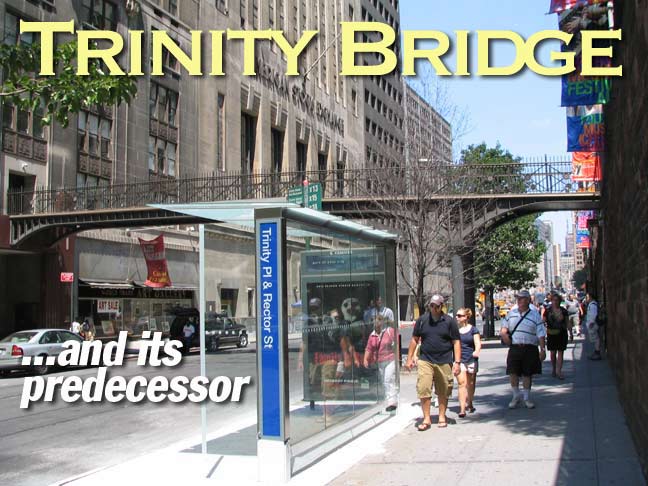Your webmaster used to grab the express bus to work back around 1989-1990 (financially speaking, I shouldn’t have, but I enjoyed walking a block to Bay Ridge Parkway and getting the coveted “one seat ride” to work on 6th Avenue and West 29th Street). Back then, the express bus company still used rickety old GM “fishbowl” buses with soft, albeit dirty seats.
Anyway the bus would go through the Brooklyn Battery Tunnel, then up Trinity Place, Church Street and 6th Avenue, and always passed under the curious iron bridge right by the back end of Trinity Cemetery. I always wondered what it was, but never investigated it.
Years later, I enjoyed the great but unheralded Patrick Reynolds’ series of little-remembered New York City history, Big Apple Almanac, in the pages of Newsday and in 1999 or so purchased one of the volumes that collected his work, shown above. One of the stories concerned an iron footbridge that spanned Broadway and Fulton Street for one year and one year only. The bridge existed because of the rivalry of two hatters. That’s right…hatters.

The story goes that in 1866, John Genin, owner of a hat shop on the southwest corner of Broadway and Fulton Streets (then, as now, one of lower Manhattan’s busiest corners) petitioned NYC Common Council to construct a bridge that would take pedestrians across Broadway for greater access to his store. In those days Broadway was a cacophonous din and downright dangerous too, with wagons, carts, mounted horsemen, and the occasional pig or two; stoplights or even traffic cops were still a few decades in the future. Despite the opposition of a rival hatter named Charles Knox, whose store was on the other side of Broadway, amazingly, an iron pedestrian bridge went up later that year (shown above. St. Paul’s Chapel, shown in the background, is still there).
Knox duly saw his sales compromised by the bridge, which cast a shadow nearly all day on his establishment, and Knox and the hatters from the shady east side of Broadway fought before Common Council with the hatters on the sunny west side of Broadway to get the bridge torn down. Knox and his allies won out and down the bridge came the very next year. Knox Hatters went on to decades of dominance, and is still around today as Arnold Hatters.
Mary E. Tucker, an African-American poet at the time, published a poem called “Loew’s Bridge: A Broadway Idyl [sic]”:
For hours I stood upon The Bridge,
Which looms like a volcanic ridge,
Above a scathing fire below.
A flaming crater of burning hearts–
And, as souls passed beneath my feet,
As weary souls passed to and fro
A knowledge came, so sad, yet sweet,
Each inner life I seemed to know.
Oh, heaven and earth! the sins and sorrows
That scarred each heart with countless furrows!
And yet I had a glimpse of love;
For maidens, pure as snow-white dove
And innocent of guile,
All heedless of this world of pain,
Passed under with a smile.
Bright rosy cheeks, the badge of health–
Eyes dancing in their mirth–
And rose-bud lips as yet unpressed,
Soft golden hair, by none caressed,
For save the passion born at birth
…and so on, for 65 stanzas, that’s right, 65, all in the stilted, formal language of poetry at that time.
In the book’s Notes, Miss Tucker describes the bridge thusly: Loew’s, or as it is commonly called, Fulton Street Bridge, was completed March, 1866, the building being supervised by the Hon. Charles E. Loew, whose name has been bestowed upon it by as Act of the Common Council of New York.It is a large ærial structure, at the intersection of Broadway way and Fulton Street, where the thoroughfare is continually thronged with vehicles of all kinds, rendering it almost impossible for pedestrians to pass.
This page has probably more than you want to know about this odd chapter in NYC history.
That brings us to our modern-day street bridge, just a few blocks south, spanning Trinity Place just north of Rector…
It looks as if it’s been there 100 years, with classic styling. It’s only been there since 1989, though:

Twelve years ago, the board of Trinity Church in Manhattan decided that its parishioners were living dangerously each time they jaywalked across Trinity Place en route from the Episcopal church to the parish house.
The solution was Trinity Bridge, a footbridge that was finally completed last month [March 1989], linking the two buildings 16 feet above the ground.
To complement the Gothic Revival church, built in 1846, the lacy iron and steel bridge ”draws on the style of the ornate wrought-iron fence surrounding the church,” the architect, Lee Harris Pomeroy, said. The 85-foot-long structure was also inspired by a cast-iron pedestrian bridge that stood at Broadway and Fulton Streets from 1866 until 1867.
”The light appearance was achieved by using a single-span truss, made and installed in one piece,” said Mr. Pomeroy, who worked with Ammann & Whitney, an engineering firm in Manhattan.
The bridge connects the second floor of the parish center to the rear porch and Gothic arch of the landmark church, near Rector Street. New York Times
Amazing how Trinity Bridge set off a meme in my head reminding me of the Broadway-Fulton Bridge that I read about almost 10 years ago and stranger still that indeed, the newer bridge was inspired by the old. That’s life in ForgottenLand.
Written and page completed 4-5AM, December 31, in lieu of sleep that stubbornly refused to come. That’s how Poe worked. And so FNY ends another year.
12/31/07



